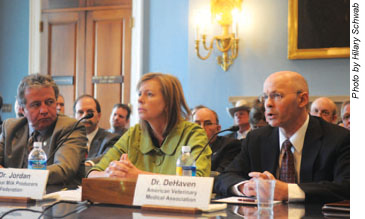Plan for mandatory ID of livestock focus of congressional hearing
The AVMA was back on Capitol Hill March 11 to express its support for a mandatory national livestock identification program, saying it would help mitigate the effects of an animal disease outbreak such as foot-and-mouth disease.

The U.S. cannot afford to wait for a crisis to make national animal identification a reality.
— DR. W. RON DEHAVEN, CEO, AVMA, TESTIFYING ON CAPITOL HILL
AVMA CEO W. Ron DeHaven appeared before the House Subcommittee on Livestock, Dairy, and Poultry to make a case for the National Animal Identification System, a program run by the Agriculture Department's Animal and Plant Health Inspection Service.
Dr. DeHaven's testimony marks the second time in less than a month that the AVMA was represented at a hearing related to veterinary medicine. This past February, he appeared before a Senate subcommittee evaluating the short supply of veterinarians working on important federal programs (see JAVMA, April 1, 2009).
At the House subcommittee hearing, Dr. DeHaven said a mandatory livestock identification program is necessary for the rapid control of disease agents entering the U.S. food supply. The ability to quickly trace the origin and movements of infected livestock could save millions of animal lives and billions of dollars, as well as shield public health and U.S. trade from profound damages, he explained.
"With full producer participation in the NAIS, we will be able to quickly contain and eradicate diseases," Dr. DeHaven said.
"The U.S. cannot afford to wait for a crisis to make national animal identification a reality," Dr. DeHaven continued. "A potential response time of 48 hours would be a vast improvement over the current, outdated system ..."
Both the American Association of Bovine Practitioners and American Association of Swine Veterinarians support premises registration as a means of effective disease management. AVMA President James O. Cook has strongly advocated producer participation in the NAIS, and the Association has worked with APHIS to implement and publicize the program to its members.
Currently, participation in the NAIS is on a voluntary basis. Since its inception in 2003, more than 500,000 premises have registered with the NAIS, less than one third of the estimated number of the nation's livestock and poultry premises. Seven states have some form of mandatory identification program.
Dr. John Clifford, deputy administrator for Veterinary Services at APHIS, told the subcommittee that the overall participation rate is "disappointing." The poultry industry has the highest degree of traceability, followed by the sheep industry. Participation in the NAIS by the pork industry is progressing well, Dr. Clifford said, but he added that the low number of cattle producers in the program is a reason for concern.
The NAIS is facing a number of challenges to full implementation, including fears that the federal government is encroaching on producers' privacy rights. Dr. Clifford assured the subcommittee that the USDA takes those concerns seriously. For instance, the USDA limits the type and quantity of the information collected and maintains only the premises registration data necessary for effective traceback or notification in animal disease situations.
"Existing federal law protects individuals' private information and confidential business information from disclosure—a fact that USDA has continually emphasized," Dr. Clifford said.
Similarly, Dr. DeHaven suggested "that in reality, the information that will uniquely identify livestock premises is the same found in any phone book."
Voicing some of those criticisms of the NAIS at the hearing was Dr. Max Thornsberry, president of the Ranchers-Cattleman Action Legal Fund, United Stockgrowers of America. Dr. Thornsberry said the USDA has been successful using existing resources and programs to protect U.S. cattle from diseases as evidenced by the near eradication of brucellosis and the notable reduction in bovine tuberculosis.
"Congress should not allow USDA to supplant these successful programs with an unproven system that is likely to consume more resources in its administration than the agency now spends in prevention, control, and eradication of cattle diseases," Dr. Thornsberry said.
Proponents of NAIS point out that animal identification systems are fast becoming prerequisites for international trade. Brazil, the European Union, Australia, Japan, and several other countries have adopted such systems, and many are mandatory. Dr. Clifford said establishing an internationally recognized system of traceability will enhance the competitiveness of U.S. exports of animals and animal products.
The lack of such a system was a factor that prevented the United States from receiving "negligible risk" status—the best status possible—for bovine spongiform encephalopathy from the World Organization for Animal Health (OIE) after the disease was diagnosed in a U.S. cow in 2003, according to Dr. Clifford.
"Receiving negligible risk status would not only enhance our ability to compete internationally, it would greatly support U.S. domestic price structures so that all producers—regardless of their interest in international marketing—would benefit when the United States expands its export markets," Dr. Clifford explained.